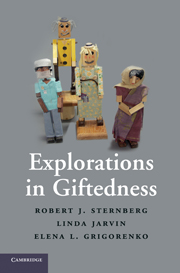Book contents
- Frontmatter
- Contents
- Preface
- 1 What Is Giftedness?
- 2 Theories of Giftedness
- 3 WICS as a Model of Giftedness
- 4 Intelligence and Giftedness
- 5 Creativity and Giftedness
- 6 Wisdom and Giftedness
- 7 Giftedness as Developing Expertise
- 8 Giftedness and Culture
- 9 Learning Disabilities, Giftedness, and Gifted/LD
- 10 Identifying the Gifted
- 11 Educating the Gifted
- References
- Index
10 - Identifying the Gifted
Published online by Cambridge University Press: 05 June 2012
- Frontmatter
- Contents
- Preface
- 1 What Is Giftedness?
- 2 Theories of Giftedness
- 3 WICS as a Model of Giftedness
- 4 Intelligence and Giftedness
- 5 Creativity and Giftedness
- 6 Wisdom and Giftedness
- 7 Giftedness as Developing Expertise
- 8 Giftedness and Culture
- 9 Learning Disabilities, Giftedness, and Gifted/LD
- 10 Identifying the Gifted
- 11 Educating the Gifted
- References
- Index
Summary
How are the gifted identified? In Chapter 1 we presented the pentagonal theory for identifying the gifted (Sternberg & Zhang, 1995). In this chapter we will review the methods most frequently used in the United States. There are many different techniques, but one of the most widespread is through the use of standardized tests. We will then present in some detail three studies in which we used alternate methods of assessment.
STANDARDIZED TESTS
A standardized test is a test given to many individuals, often across the nation, to develop appropriate content and scoring comparisons. It is administered and scored according to uniform procedures. Uniform, or standardized procedures are the key to the definition of a standardized test. Constructors of these tests try to assure that every student taking the test has a similar experience. Standardized tests are usually purchased from test publishers. They sell the tests only to those qualified to use them. Not all tests purchased from publishers are standardized. For example, textbook publishers often offer banks of test questions. The publisher, in this case, does not try to standardize the experience of every student who is tested. Teacher-made tests are not standardized. Instead, they are created by, or for, individual teachers who use them on only a limited number of students. Each teacher scores the tests he or she creates in an individual way. Ideally, all tests of achievement should be closely tied to the learning that students have done (Dochy & McDowell, 1997).
Information
- Type
- Chapter
- Information
- Explorations in Giftedness , pp. 177 - 212Publisher: Cambridge University PressPrint publication year: 2010
